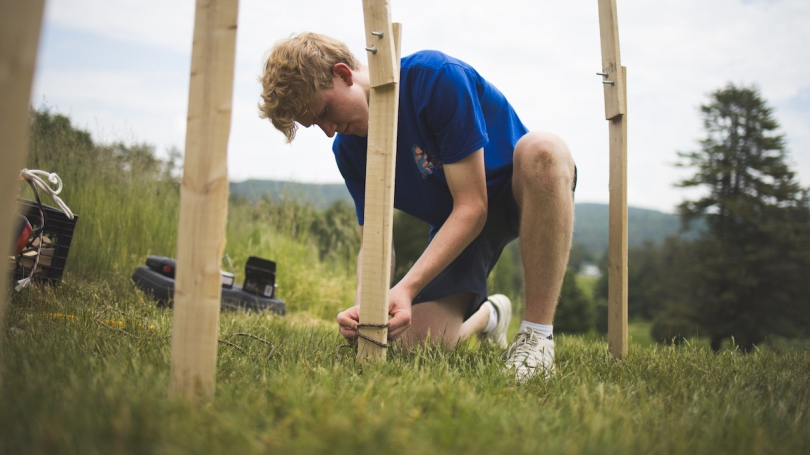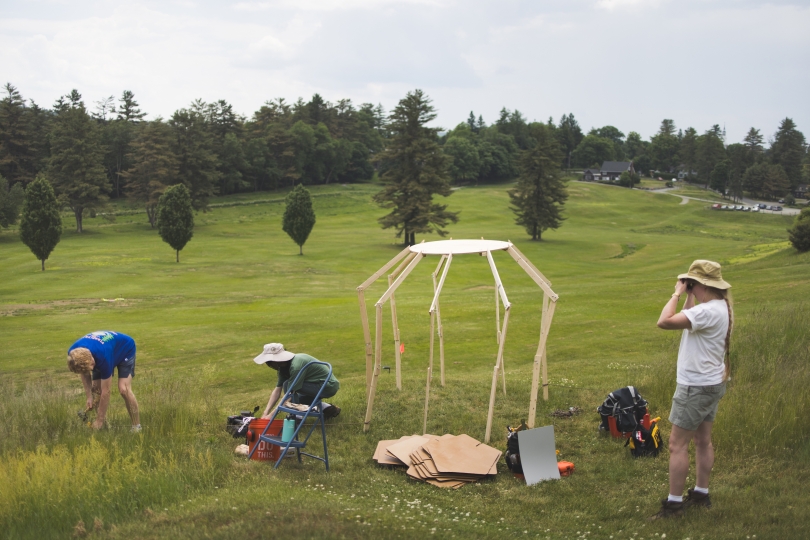

The open-air exhibit features student artists from across New England.
Dan Rockmore was walking his dog on the former golf course at Dartmouth near Pine Park when he had an epiphany.
"It struck me one day as I looked down from the northwest corner what a beautiful setting it would be for a sculpture park," says the professor of math and William H. Neukom 1964 Distinguished Professor of Computational Science. "The best sculpture parks simultaneously highlight natural beauty and human creativity. That feels like a part of the Dartmouth ethos."
Looking out at the rolling valley, surrounded by woods, Rockmore realized that an open-air sculpture exhibit themed around climate change was a natural fit for Dartmouth, whose researchers, artists, and students routinely address issues of sustainability—and where President Sian Leah Beilock recently unveiled the Dartmouth Climate Collaborative, a commitment to invest more than $500 million in climate-related capital improvements to reduce carbon emissions by 100% by 2050.
By inviting young artists from universities and colleges across New England to take part in the exhibit, Rockmore envisioned Dartmouth as a "locus of artistic work of this kind."
This week, thanks to Rockmore's partnership with colleagues in the Department of Studio Art, and funding from the Dean of the Faculty of Arts and Sciences and the Office of the Provost, the inaugural Dartmouth Sculpture Biennale kicks off in the North End of campus on part of the former golf course. The biennale is open to the public through Sunday, June 23.
Thirteen works arrived from across New England in response to its rallying call for submissions: "What if we ask the youngest brightest minds to think, create, and challenge themselves with new ideas for sustainability, ideas that are not driven by how bad things are but instead by how we can do better?"

Rockmore organized the biennale with Senior Lecturer in Studio Art Karol Kawiaka, Associate Professor of Architecture Zenovia Toloudi, and intern and recent studio art graduate Kyle Hartin '21.
"Climate change is one of the great problems of our time that we need to address," Kawiaka says. "We hope visitors are inspired to take action to address climate change themselves at some level in their work and lives by the beauty of the land and the work they see in the exhibition."
"We have been lucky as architecture faculty to help shape the exhibition," says Toloudi, who credits Rockmore with insisting that "big ideas" be at the heart of the biennale. "And Karol empowers the group with her expertise," she adds. "It has also been fascinating to get to know and work closely with Kyle Hartin, whose passion for art and curation, organizational skills, and work ethic are rare treasures."
All of the sculptures on display will be featured in a forthcoming catalog, and a public reception will take place at the biennale on Saturday, June 22, from 4 to 5:30 p.m., with food, drinks, and entertainment.
Ultimately, the organizers hope to ignite dialogue about the environment and climate change.
"The best artists have the ability to make you think about difficult challenges in new ways," Rockmore says. "Climate change is an existential challenge. Great art can help galvanize activity and creative thought around this challenge."
From the annual Neukom Institute Literary Arts Awards, which Rockmore founded and coordinates as institute director, to his recent writing about AI and poetry, Rockmore has long pushed past traditional boundaries in math and computer science to champion multidisciplinarity and the power of human creativity.
"I hope that everyone comes away feeling a little more thoughtful and more at peace after a walk out of doors and inspired by the creative spirit," he says.